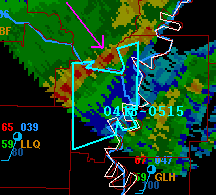
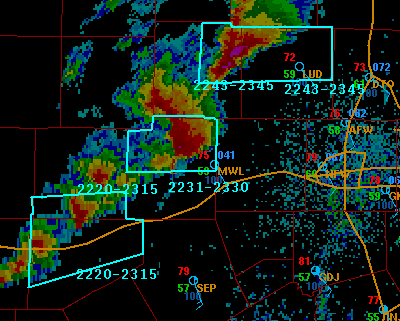
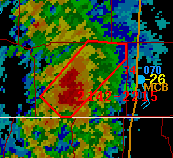
by
Posted: 18 September 2008 Updated: 11 May 2011: added some additional text.
As always, this is my opinion. If you wish to communicate with me regarding this topic, use cdoswell # earthlink.net - either click on the email link or cut and paste the email address, replacing " # " with "@". Your correspondence with me, along with my response, might be added to this page as a result - if you're not willing to make your comments public, either don't send them in the first place or convince me I shouldn't make them part of this public discourse.Having been involved with some recent discussions about introducing incorporating non-meteorological information into tornado warnings in order to improve service to the public, I offer the following thoughts about how this should be done.
There are certain things that must happen in order for weather information to be of value to users, even if the forecasts are perfect (which virtually never happens). I see these as:
If any of these links in the chain are broken, then the weather information is useless to the user even if it's perfectly accurate. The best forecasts can wind up having little or no value to most users.
With tornado (or severe thunderstorm) warnings, in general, a meteorologist issuing a warning has assessed the weather situation and reached some threshold at which s/he feels that a warning is necessary. Strictly speaking, this can be understood in terms of a threshold probability value - no weather forecast (and a warning is a forecast) should ever be considered absolutely certain. See here for a discussion of probabilities in this context. There's inevitable uncertainty in warnings, despite the fact that this uncertainty is (for the most part) not being conveyed to the public.
The issuance of a warning means that the meteorologist believes that the threat of a tornado is high enough that at least some people might need to respond to the tornado threat. Of course, in the weather office, it's impossible to know everyone's particular circumstances - some people might need to take action at a lower probability threshold than others (e.g., those living in mobile homes versus those who live in reinforced concrete bunkers). Since the person issuing the warning can't possibly know everyone's circumstances, it's essentially up to the user to decide what to do. I oppose warnings that include "call to action" statements for this reason. If forecasters are telling people what to do, it can't be on the basis of adequate information about everyone's situation. How can the warning forecaster know what each individual should do?
Since most people don't even own weather radios, it follows that most people don't get their information about weather hazards directly from the public weather service. Most people get their information via television, now, so they may choose the weather broadcaster they trust the most, and listen to that broadcaster for information. The level of trust that the general public has in the public weather services is not something I know anything about. The broadcasters measure their impact by ratings, which in a hazardous weather situation probably constitute a reasonable measure of the credibility of their broadcasters. Note that the perception of credibility may not be warranted by the actual accuracy of the information provided.
A challenge in getting people to take action is the "normalcy bias" - by far the majority of people have never experienced a devastating weather disaster, and it's understandable that they wouldn't believe that it's actually going to happen to them. They likely seek confirmation that the hazard is actually going to affect them this time. I don't believe this is an unreasonable or stupid viewpoint. Unfortunately, the time spent trying to confirm a threat to them personally is time lost if the need for action actually arises. Thus, a particularly important piece of information that could be of great help to users is for warnings to include time-of-arrival estimates, and the users need to know that the information is simply an estimate, and not always exactly correct. Some TV broadcasters do this very well. Others ... well ...
It should be evident to anyone reading this that weather forecasters are educated and trained about the dynamics of weather systems and how to use that knowledge to forecast the weather. We aren't educated or trained in psychology or sociology. We aren't even necessarily very adept at communicating what we know to other meteorologists, let alone to non-meteorologists. Hence, we traditionally have struggled with how to word our forecasts to convey weather information accurately. Words are notoriously unreliable at communicating information - some people interpret a given phrase a certain way whereas other people interpret the very same phrase in a very different way. Just what does "showers likely" mean? Although it's reasonable to ask forecasters to improve their communication skills, it's unrealistic to expect most forecasters to become communications experts. An important facet of warnings that's not yet being conveyed to the public is uncertainty - to the public, there either is or there isn't a warning in effect.
The dichotomous (i.e., binary) nature of warnings at present means that a warning forecaster has only two options - issue a warning or not issue a warning. However, the penalties for an error aren't symmetric. If a warning isn't issued and a killer tornado occurs, the forecast is "penalized" much more severely than if a warning is issued and no tornado occurs. Hence, there's a distinct bias toward overwarning - better safe than sorry (or, more pejoratively, C.Y.A.). The angst over whether or not to issue a warning could be mitigated significantly if the forecaster had the option of expressing warning uncertainty information via probability. At the moment, probabilistic warnings are being considered, but there's considerable concern about how best to convey that information in a warning.1 I should add that I have little idea of how best to convey that uncertainty - I'm not offering any magic formula for success in this. I don't know enough to be able to formulate a successful strategy for probabilistic warnings, despite my ultimate belief that we as meteorologists should move in this direction. Much more research needs to be done (e.g., national surveys) in order to develop probabilistic warnings in the most effective way possible. Implementing probabilistic warnings without this research and without a public education campaign to let users know what the probabilities mean and how to use them easily could do more harm than good!
Should forecasters alone take on the task of trying to produce a product that will be effective at communicating weather information? I don't think so. Forecasters haven't the knowledge, nor the inclination to go about acquiring that knowledge, needed to be effective at reaching "the public" - note that "the public" includes everyone from newborn babies to Ph.D.-level meteorologists. What we refer to as "the public" is quite diverse, not a monolithic block. What works for one segment of the public will fail completely with some other segment. Some segments of the public will be very unlikely to change their behavior no matter how sophisticated the communication of weather information becomes. Witness the death of the old man (Harry Truman - but not the late President) at Mount St. Helens in May of 1980; he was bound and determined to stay there at the foot of the volcano, no matter what anyone told him. He stayed ... and died, but his body was never found. It's unrealistic that forecasters could ever hope to be 100% effective at stimulating a particular set of reactions from the public to the weather information they're attempting to communicate.2
It's quite difficult to be a good warning forecaster. It requires all the education, training, and experience that a single human being can muster to become reasonably good at this challenging task. If our forecasters also have to be sociologists, psychologists, and communications experts in addition to the job they already have, I can guarantee that most of those responsibilities would wind up being substantially less than perfectly executed. Let the forecasters stay focused on what they can be good at - issuing weather forecasts. Forecasters should be freed from all other responsibilities other than forecasting, allowing them to pay close attention to the very challenging tasks they must master to be good at their job.
If I'm willing to absolve the forecaster of the sole responsibility for the value of the warnings, who then should be responsible? Certainly someone has to take this on! I propose that we introduce another link in the chain between the forecaster and the public (in addition to the media broadcasters, who already have the lion's share of the dissemination responsibility for warnings). There should be another, separate group of people, either employed by the same agency that employs the forecasters, or by some other group willing to invest in ensuring the value of the warnings. [Note added: I've just found out about the Disaster Prevention Research Institute at Kyoto University in Japan. See their "Integrated Arts and Sciences for Disaster Reduction" group. It turns out they have a division employing sociologists and psychologists to interact with their physical scientists. This concept is pretty close to what I have in mind! At least there's some people involved with disaster mitigation who grasp the importance of this concept.] Within this group, there should be communications experts, psychologists, sociologists, and whatever other disciplines might be able to contribute to the process of translating the information provided by the forecasters into appropriate products suited to various segments of the public. They would conduct the disciplinary research (including comprehensive surveys) needed to provide a factual basis for modifying forecast products to serve the public. They would also need to help with the public education process so that users can understand the weather information and can learn how best to use that information to make decisions based on it. And they would need to work closely with forecasters to ensure that their recommended version of the weather information to go to the public is an accurate reflection of the forecaster's intentions. If the interface between weather information and the public is important, and I believe it is, that interface is too important to leave entirely in the hands of weather forecasters!
And it's even more important that decisions about how best to serve the public are not made only by NWS and NOAA management! Frankly, NOAA / NWS management is dominated by people who know little or nothing about either forecasting or the other disciplines (sociology, psychology, communications, etc.) that are necessary to come up with improved warning products. These managers may have opinions, of course, but their opinions aren't typically fact-based. There's precious little information in existence about how "the public" perceives and uses weather information to make decisions - some studies have been done, but they're far from comprehensive enough to design a national plan for improving tornado warnings - and, especially, how to incorporate uncertainty information in the warnings. Studies done for other hazards, such as dam breaks or hurricanes, may not be perfectly compatible with the tornado hazard, in particular. We simply don't have enough information at this point to be confident in designing a tornado warning that conveys uncertainty, despite a general scientific consensus that forecast uncertainty information is a critical component of any forecast (repeat: a warning is a forecast, lest anyone think otherwise). The history of the NWS includes one noteworthy attempt to introduce uncertainty information - in precipitation forecasts - the probability of precipitation (or PoP). When the change to PoP was made in the 1960s, there was little or no effort to bring the public up to speed about its meaning or how to use it in decision-making. To this day, the public is confused and often scornful about the meaning of the PoP forecasts they receive. As I see it, it's a classic screw-up in public relations by the NWS and if the choice is made to move forward with probabilistic warnings without first doing our homework regarding its perception and impact on the public, and educating them beforehand about its meaning and use, we simply will have made the same stupid mistake all over again.
I've said all along that the time to develop a proper appreciation for the hazards posed by severe convective weather and to develop an action plan in case severe storms become imminent is not in the time between the issuance of the warning and the arrival of the event (which can be as a short as a few minutes). The time for careful consideration of how an individual should deal with the severe convective storm hazard is months and even years before a storm begins to be a potential threat. Some people might choose to invest in a "safe room" in the new house they're building or even retrofit a safe room into their existing home (much more expensive). Some people might consider evacuation routes. And so on ... everyone should develop a plan for what they would do in case severe storms approach, but the details of those plans would vary, depending on the specific circumstances of an individual's life. Those circumstances change over the years and as they change, the action plan may have to be modified. The intermediary group I'm recommending would need to take a very active stance in promoting storm-readiness on the part of the public - at least those segments of the public willing to invest some resources in becoming prepared. This group would also need to stay tuned to the public and as the world evolves, the details of how best to serve the public when it comes to conveying information about tornado hazards would have to change. We've seen an increasing urbanization, and in urban situations, people are less connected to the natural environment than those living in rural areas. This requires a different strategy for urban versus rural regions. Increasing numbers of non-English speaking citizens are not likely to be well-served by English-only warning products, but how many different languages should be accounted for in warnings? The technology of communication is changing incessantly. What works today might be obsolete tomorrow and the dissemination process might look very different in 30 years. The landscape in which weather information is created is also changing so the content of the weather information issued by forecasters about tornadoes could look quite a bit different in 30 years. My proposed intermediary group would need to coordinate all of this to provide the best possible value to the most people within the diverse user community. After the introduction of probabilistic warnings, there would be a continuing need for studies in public perception - the whole warning "landscape" (that includes the weather and non-weather sides) changes constantly. The job of understanding and accounting for that landscape in public tornado warnings would never end. Coordination between the weather side and the other elements would have to continue indefinitely. This isn't a job that can be done once, and be done with it.
An important question everyone needs to answer for themselves is what threat threshold would be appropriate for them to take action. If someone is physically handicapped in some way that increases the time needed to take shelter, a lower threshold would be needed than for someone who's physically able to reach their shelter quickly and easily. Hospitals might need a lower threshold, as might folks who live in mobile homes, or nursing homes, or day care centers. Given the relatively short lead times between the issuance of a warning and the arrival of a tornado, each person or group needs to decide for themselves the level at which action is needed. Waiting for someone to tell you what to do personally is a bad strategy! Therefore, another important role for the intermediate group I'm advocating is continuing public education and obtaining feedback from the public.
If we're going to improve responses to tornado warnings, I believe we need to address a perception that appears widespread in the public: that NWS warnings absolve the public of any responsibility for their own safety in tornado situations. Weather forecasting will always be uncertain to some degree, so people need to understand and accept their personal responsibility for the safety of themselves and their loved ones. We won't ever be able to tell individuals they're going to be hit (or not) by violent tornado winds. Personal responsibilities include taking some preparatory actions well before the impending arrival of a potentially tornadic storm. Of course, it may be that my belief about this is wrong - thus, the need for surveys and the acquisition of quantitative, factual information about public perceptions before we move ahead.
At the moment, tornado fatalities seem to have hit bottom. A historical perspective is provided by Brooks and Doswell (2002)3 - a general decline in tornado fatalities that began around 1925 has shown signs of leveling off and perhaps is now even increasing. At present, the majority of tornado fatalities every year are in mobile homes, and more and more people are living in mobile homes in tornado-prone areas, perhaps in part as a response to economic trends making a permanent home less affordable. Nevertheless, the annual fatality toll from tornadoes is now generally under 100. As always, the annual death toll reflects the fact that having a significant tornado interact with a large concentration of people is a relatively rare event. Rare doesn't equate to impossible, and it's clear to those aware of tornado history that large fatality counts are inevitable, if unlikely in any given year.4 Although it's possible to see the inevitability of tornado disasters in the future, doing something about it is much more difficult.
It comes down to economics, as always. How much are we as a nation willing to invest in reducing the fatality counts from tornadoes in the future? Is this the most important problem facing the USA? No, not even close. But if it does merit some investment to prevent fatalities, can we justify increasing the existing investment? I've discussed this from a slightly different angle here, but given that my context within this essay is the creation of an intermediary group of diverse disciplines to act on the interface between warning forecasters and the public, the issue comes down to whether or not the NWS is going to back such an effort.
Again, my take on the situation is that NWS management has indicated a general unwillingness to address important issues. Apart from anything they might have to say about things, consider their actions as a more accurate reflection of the commitment than their words. In particular, consider the evolution of the surveys done after natural disasters (including tornadoes). There is clear evidence that these surveys are being "dumbed down" from a wide-ranging consideration of scientific and technical issues to a very narrow topic: did the killer tornadoes have NWS warnings in advance of them? If so, the service is deemed acceptable, no matter how superficial that assessment might be. NWS management doesn't show much more than superficial interest in learning from fatality-producing tornado events. A true "service assessment" would necessarily include surveys of the victims and non-victims in the vicinity to determine their perceptions, what actions they took and why they took them, how they perceived the warnings, and so on. It would also give the actions of the forecasters in the warning chain a much more comprehensive scrutiny, as well as a careful consideration of how science was applied to the problem, and the vulnerability of the structures in the tornado path (and how that related to fatalities).
I believe that NWS management isn't particularly committed to public service, unlike many of the warning forecasters. NWS management is more concerned with how things appear than how things really are. If there's no major hue and cry from the politicians and/or the media about NWS services, then not much of substance is likely to happen. Would the NWS be willing to work to increase their budget (which, in modern politics, means decreasing some other agency's budget!) to support a team of sociologists, psychologists, and communication experts to work with NWS forecasters to help design more effective forecast products? I suspect such a suggestion would be rejected without a moment's hesitation. NWS management is under intense pressure to reduce their budget, not increase it! About the only way my proposed intermediary group would ever come to be within the NWS would be for some other part of the NWS to be abolished and its budget allocated to the intermediary group. This obviously would be vehemently resisted by any agency whose budget would be sacrificed. How would NWS management convince their overseers to reverse that budget pressure, to support an increase in the NWS budget? Where's the political support for such an initiative? Where's the groundswell of public opinion? What powerful media have come out in favor of such a program? Without that sort of political clout, there's no chance to prevent the impact of future tornado disasters on the victims. We in the science community can see such things coming on the basis of the historical record of natural disasters, but are powerless to prevent them.
The current sort of tornado disasters, exemplified by the 3 May 1999 tornado outbreak, is apparently not effective in creating permanent change. Some minor things are done, but once the media feeding frenzy moves on to other things, it's back to business as usual. It seems that a few score fatalities are just not enough to cause any substantive change. Once the dust clears, public attention is drawn to other topics and the relatively small number of victims winds up mostly on their own to recover as best they can with existing institutional support (if any).
In the final analysis, I'm afraid, the public is getting about the level of service from the NWS they're willing to support. A few score people every year are killed by tornadoes - this toll falls disproportionately on the poor, the handicapped, the elderly. There apparently isn't much of a collective national concern about this relatively modest death toll to invest in new ways to prevent future fatalities. I suppose this might be described as "acceptable losses" by US society as a whole. I've argued elsewhere (here, too) that the existing warning system can be seen as doing a reasonably good job, especially for the tornadoes most likely to result in large numbers of fatalities. Is there a compelling need to improve on the existing warnings via increased NWS expenditures? Is there justification for costly new satellites and radars just to reduce tornado fatalities? As noted, I don't believe the public as a whole thinks so. Otherwise, there would be pressure on politicians to do something. I believe that the present system could be improved, and future fatalities reduced, but this will take much more effort in non-meteorological areas: sociology, psychology, communication, public education, acquisition of fact-based information about public perceptions and response to warnings, etc. This isn't very advantageous to the meteorological science community (which seeks to understand more about tornadoes, as opposed to public response to tornado warnings), but I believe it would be most advantageous to the public - and the future victims of tornado disasters.
If not the NWS, then who would be willing to find the resources for a center that would coordinate non-meteorological information with warning forecasters (and perhaps research meteorologists) to produce improved warning products? At this moment, I have no clue. Anyone willing to step up should speak up!
Update: 01 October 2008
I recently had the following email exchange (lightly edited) with NWS meteorologist Coleen Decker:
Your recent essay entitled, “How to improve tornado warnings” was brought to my attention by our WCM. Although I won’t go into any detail about my personal opinions, I think that your essay brings up a good point that we should be considering some of the non-meteorological aspects of warnings. There are many in the field that would argue we need to stick to the meteorology. However, when I took the entire series of Fire Behavior courses for my IMET job, it was so that I would be able to understand the needs of the firefighters to do a better job…not so that I could become a fire fighter, but a basic understanding is so necessary.
Response: As I argued above, meteorologists should be allowed to be meteorologists, although broadening our perspectives to include some awareness of other disciplines is always of value.
To that end, there is a movement that is trying to integrate the Non-meteorological aspect of warnings that I want to bring to your attention. Although I have not been a participant in this program yet, I have expressed interest. Many of my fellow IMETs have participated and endorse this. At least it is a step in the right direction. Here’s more information that I hope you will enjoy: http://www.sip.ucar.edu/wasis/
Response: I'm aware of WAS*IS - in fact, its leader, Eve Gruntfest, is currently occupying the office next to mine at the Intergalactic Weather Center and we chat frequently when she and I are both in town at the same time! That something is moving along these lines is a good thing and I certainly support it. But we're a loooooong way from having the information we need to make informed decisions about how to incorporate uncertainty into public severe weather warnings so as to be the most effective.
Given this exchange, it's also appropriate to mention the following NWS program which recently came to my attention:
This program is certainly attempting to deal with the thorny issue of inserting uncertainty information into public weather forecasts of all sorts. However, I see their effort as being focused on the admittedly non-trivial task of solving the meteorological issues, rather than paying attention to the challenge of conveying meteorological information to the public in a way that incorporates uncertainty and is effective - at least as effective as the current non-probabilistic forecasts and hopefully more so as a result of incorporating uncertainty. This latter challenge is much more important, as I see it, than the technical challenges from the meteorology side, for reasons explained above.
Update: 13 November 2008
I recently had the following email exchange (lightly edited) with { } meteorologist Roger Edwards (affiliation removed):
So-called "storm based" warnings, while far from the ideal end, have been a step in the right direction when performed the right way. Here's how: Reduce false-alarm area by fanning the warning ahead of the projected path of the severe storm (or for tornado warnings, the most probably tornadic subset of the storm). I've seen this done right, and when it is, it can eliminate hundreds to thousands of square miles (and in areas of dense populations, hundreds of thousands of people) from unnecessary warning. A natural future extension of this concept in time is probabilistic warning fans, analogous in some way to NHC probability fans for hurricanes. I've advocated this for well over a decade, and as you and commenters have alluded, there are some early efforts within parts of the Integrated Warning System to advance in this direction.
Response: Unfortunately, if we move too fast in this direction, BEFORE we've learned more about how 'the public' can best be informed about uncertainty in warnings, we might do more harm than good. I think NHC has had a lot of 'growing pains' with their probabilistic products - more so than the SPC's efforts - perhaps because of the huge societal impact of hurricanes and also perhaps because of the way the probabilities are generated. If we move prematurely into probabilistic severe convective storm warnings, we could wind up reducing the effectiveness of the product! We HAVE to do our 'homework' first and that includes a huge effort to educate the public about any new procedures before they're implemented.
Until we have probabilistic warnings, we've got "storm based" warnings. That's the reality. For background, it must be noted that warnings aren't supposed to be drawn yet across CWA borders; though this supposedly will change sometime in the next few years. This doesn't affect warnings entirely *within* a CWA, however.
We know how "storm based" warnings can be done best. One way "storm based" warnings are not done best is to draw them around county lines, as if a storm suddenly will become benevolent and merciful, and shut off its tornado or severe hail production on a political border. That this practice violates the very core principle of "storm based" warning is self-evident. It degrades service back to a county-based method, which the whole transition was meant to stop.
I've attached several graphical examples (see below), but I could have attached hundreds! County-based "storm based" warnings are rampant and violate each of these ideals you expressed:
1a. The information must reach the intended user
If a warning is drawn along county lines, this means someone on the "wrong" side is not an intended user. Except in the rare scenario where the danger area is projected to track parallel to, and one side of, a straight county line, how can this practice fail to either include or exclude folks who shouldn't be included or excluded?
2. Let the forecasters be forecasters**
**Compulsion of forecasters to draw warnings on county lines has nothing to do with forecasting, instead revolving around garbage such as jurisdictional politics and the failure of county code-based weather radio systems to be adapted *in advance*, before 2007, to the "storm based" warning format. It also provides inconsistent service to those on the "wrong" side of those lines, through no fault of those residents.
Fortunately, the solution on the forecaster end to this problem is stunningly simple: Ignore the county lines. Turn off the underlying map and draw for the *storm*. After all, it is supposed to be a "storm based" warning. Many forecasters and several WFOs do it the right way on a regular basis, and as such, set a good example. If they can, why not everyone?
Response: Since when in the NWS does the correctness or incorrectness of a set of actions have anything to do with how decisions are made at any level? In my decades of experience with the NWS, it's evident that even when management gets behind an idea that has real merit, the application of that idea in operational practice can be distorted by 'local initiative'. In fact, I think we occasionally applaud that very same 'local initiative' when the local practitioners follow some independent path with which we agree.
Put more succinctly - I don't see an easy way to accommodate the conflict between the need for uniformity in operations and the need for individual practice in local offices to depart from that uniformity when it isn't working the way it should. Some sort of middle ground is probably best, which likely will produce some abuses at both extremes.
On the national end, it's clear that sufficient foresight and planning would have resulted in tailoring the weather radio alarming to the geography of "storm based" warnings before their inception. [Foresight...what's that?] Yet, despite that inexcusable oversight, it's still not too late. This fix needs to be done, preferably using GIS and GPS based solutions where -- much as with modern cell phones -- receiving hardware can be fitted (and retrofitted) with GPS or other location-determining capability. This way, only those units in (or within a programmable distance near) a warning will be activated by said warning. Hence, no more involvement of county lines in warnings!
Response: I certainly agree with this ... but ... I'm not very confident I can influence how this is being done.



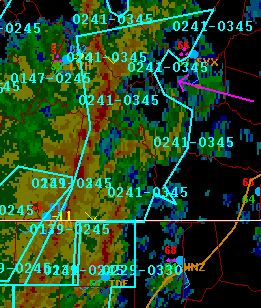
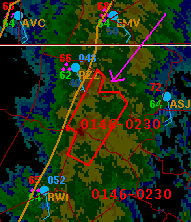
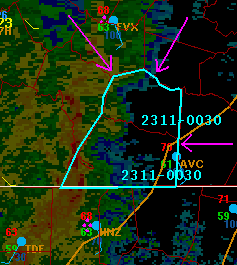
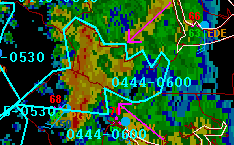
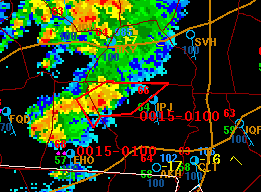
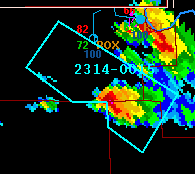
1 Whatever other challenges are associated with the use of probabilities, the interpretation of probability numbers is relatively unambiguous; a 90% probability is more certain than an 80% probability, which is in turn more certain than a 50% probability. The difficulty with interpreting probability numbers is not inherent in the numbers - rather, it's in the definition of the event being forecast. Does a 90% chance of a tornado mean that my house has a 90% probability of being hit in the next hour? Or does it mean that my county has a 90% probability of being hit? If the definition of the event being forecast is made clear, then the probability numbers are unambiguous at conveying the uncertainty.
2 In fact, even if my dream of an intermediate group between forecasters and the public becomes a reality, there always will be those who won't respond properly to tornado warnings and are more likely to come to harm as a result. I'm not even sure I know how to define a realistic "perfect" response - an unrealistic definition is that everyone would receive and understand the meaning of the warnings, and use them to make the proper action decisions. I'm confident we could do better than we are at the moment, but I have no factual information at the moment about how well we're doing in quantitative terms, so we need that information now to have a factual basis for evaluating future changes to the warning system.
3 Brooks, H.E., and C.A. Doswell III, 2002: Deaths in the 3 May 1999 Oklahoma City tornado from a historical perspective. Wea. Forecasting. 17, 354-361. (available here)
4 For some discussion about the future disaster potential from tornadoes, see:
Wurman, J., C. Alexander, P. Robinson, and Y. Richardson, 2007: Low-level winds in tornadoes and potential catastrophic tornado impacts in urban areas. Bull. Amer. Meteor. Soc., 88, 31–46.
with some cautionary thoughts about the estimates in the preceding:
Brooks, H.E., C.A. Doswell III, and D. Sutter, 2008: Comments on 'Low-level winds in tornadoes and potential catastrophic tornado impacts in urban areas'. Bull. Amer. Meteor. Soc., 89, 87-90. (available here)
as well as the response from the authors:
Wurman, J., C. Alexander, P. Robinson, and Y. Richardson, 2008: Reply to comments on 'Low-level winds in tornadoes and potential catastrophic tornado impacts in urban areas'. Bull. Amer. Meteor. Soc., 89, 90-94. (available here)
For some additional thoughts about potential tornado disasters associated with large-venue events, see here. This is another example of a challenge that confronts economics head-on. The costs associated with hazards to large-venue events (fall university football games in the tornado-prone plains, the Indianapolis 500, outdoor amusement parks, etc.) create a natural hesitancy to mitigation attempts - those putting on such events are very reluctant to cancel the event because of huge economic losses for false alarms. Event organizers want a yes-no decision from the weather community and a 100% guarantee that a "yes" answer means the facility will be struck - a meteorological impossibility. Having a tornado hit such an event has a relatively low probability, but the potential for extreme impacts: hundreds and possibly thousands of fatalities (and many lawsuits, of course). And even low-probability scenarios will occur eventually, if we wait long enough.